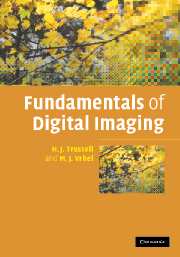Book contents
- Frontmatter
- Contents
- Preface
- Acknowledgments
- 1 Introduction
- 2 Mathematical representation
- 3 Elementary display of images
- 4 Quantization
- 5 Frequency domain representation
- 6 Spatial sampling
- 7 Image characteristics
- 8 Photometry and colorimetry
- 9 Color sampling
- 10 Image input devices
- 11 Image output devices and methods
- 12 Characterization of devices
- 13 Estimation of image model parameters
- 14 Image restoration
- A Generalized functions and sampling representation
- B Digital image manipulation and matrix representation
- C Stochastic images
- D Multidimensional look-up tables
- E Psychovisual properties
- References
- Index
4 - Quantization
Published online by Cambridge University Press: 06 July 2010
- Frontmatter
- Contents
- Preface
- Acknowledgments
- 1 Introduction
- 2 Mathematical representation
- 3 Elementary display of images
- 4 Quantization
- 5 Frequency domain representation
- 6 Spatial sampling
- 7 Image characteristics
- 8 Photometry and colorimetry
- 9 Color sampling
- 10 Image input devices
- 11 Image output devices and methods
- 12 Characterization of devices
- 13 Estimation of image model parameters
- 14 Image restoration
- A Generalized functions and sampling representation
- B Digital image manipulation and matrix representation
- C Stochastic images
- D Multidimensional look-up tables
- E Psychovisual properties
- References
- Index
Summary
When an analog signal is transformed to a digital one, it is necessary to limit the representation to a fixed number of bits. This chapter discusses the best way to distribute those bits across the range of possible values. The quantization problem is no different in two dimensions than in one dimension. The first task of quantization is the definition of the term “best.” This task requires not only the definition of an error metric, e.g., mean square error, but also the definition of the space in which the error is measured. The choice of the appropriate space is determined by the physical properties of the image that is being digitized, as well as the intent of the user of the digital data.
Most mathematically based quantization schemes use the mean square error as the error metric because of the ease of analytical manipulation. Since the eye is not a mean square error detector, quantizing for minimum mean square error (MMSE) is not usually visually optimal. However, such quantization rarely results in unacceptable images if an appropriate space is chosen for the quantization. Subjective quantization schemes are common and are often implemented using a look-up table (LUT).
We will first briefly consider the selection of an appropriate space for the image data. After a space is chosen, mathematically optimum quantization can be obtained by use of the MMSE criterion. We will show how to use this for both monochrome and color images.
Information
- Type
- Chapter
- Information
- Fundamentals of Digital Imaging , pp. 61 - 76Publisher: Cambridge University PressPrint publication year: 2008
